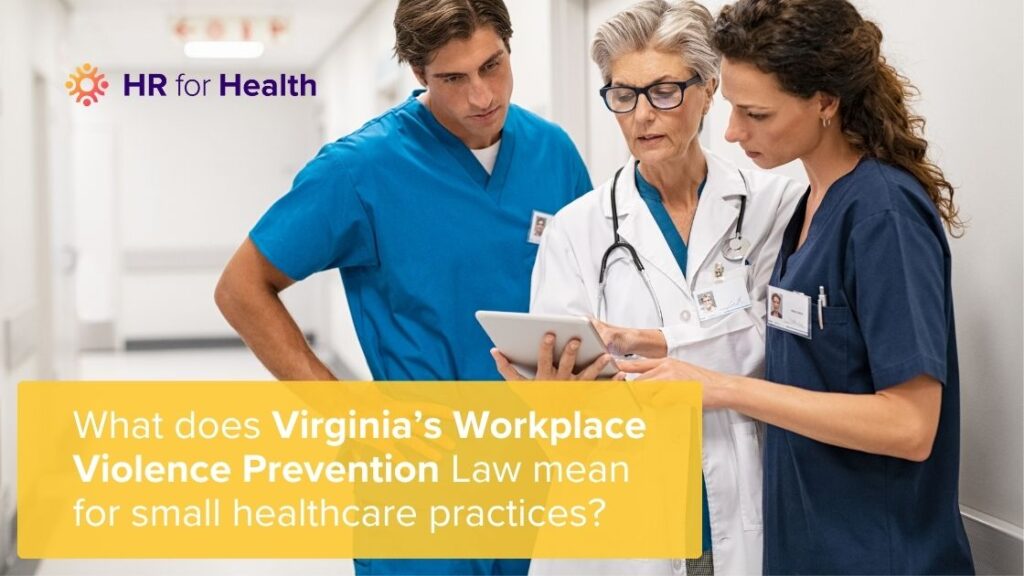Virginia has taken a significant step forward in protecting healthcare workers by enacting comprehensive workplace violence prevention legislation that requires hospitals to implement robust reporting and prevention systems. While this law primarily targets larger hospital systems, healthcare practices of all sizes should pay close attention to these developments as they often signal broader regulatory trends affecting the entire healthcare industry.
At HR for Health, we help healthcare providers stay on top of changing healthcare-related employment laws and recognize that workplace violence prevention is becoming an increasingly critical concern across all healthcare settings, from small family practices to large specialty clinics.
Overview of Virginia’s Workplace Violence Prevention Requirements
Virginia’s new workplace violence prevention law establishes mandatory reporting requirements for hospitals, reflecting growing recognition that healthcare workers face violence at rates significantly higher than other industries. The legislation requires hospitals to report workplace violence incidents to state authorities within specific timeframes and maintain detailed documentation of prevention efforts.
The law requires hospitals to develop comprehensive workplace violence prevention programs, which include staff training, incident response protocols, and regular risk assessments. These requirements acknowledge that healthcare environments present unique challenges where patients experiencing pain, mental health crises, or medication effects may become aggressive toward staff.
Key provisions include mandatory incident reporting within 24 hours for serious workplace violence events, annual submission of violence prevention program assessments, and penalties for non-compliance that can reach significant financial amounts. The legislation also requires hospitals to maintain detailed records of all workplace violence incidents, including near-misses and verbal threats.
Why This Matters for Non-Hospital Healthcare Practices
Although Virginia’s law specifically targets hospitals, smaller healthcare practices should view this legislation as an indicator of expanding regulatory focus on healthcare workplace safety. Regulatory trends typically begin with larger institutions before extending to smaller practices, making proactive preparation possible for long-term compliance.
Healthcare violence affects all practice types, not just hospitals. Medical offices, dental practices, and outpatient clinics face similar risks from agitated patients, family members experiencing crisis situations, or individuals seeking controlled substances. The underlying safety concerns that prompted Virginia’s hospital requirements apply equally to smaller healthcare settings.
Insurance companies and liability carriers increasingly expect healthcare practices to implement workplace violence prevention measures. Practices that demonstrate proactive safety programs often receive favorable insurance rates and reduced liability exposure, making prevention programs financially beneficial beyond compliance considerations.
Common Workplace Violence Risks in Healthcare Settings
Patient-Related Violence Incidents
Healthcare environments create unique circumstances that can trigger violent behavior from patients and their families. Pain medication effects, anxiety about medical procedures, and fear of diagnosis can cause normally calm individuals to become aggressive or unpredictable.
Mental health crises frequently occur in medical settings, even when mental health isn’t the primary reason for the visit. Patients experiencing panic attacks, severe depression, or substance withdrawal may exhibit violent behavior that staff must be prepared to handle safely and professionally.
Environmental and Staffing Factors
Physical practice layouts can either increase or decrease the risk of violence. Practices with multiple exit routes, clear sightlines between staff areas, and secure medication storage create safer environments than those with isolated patient areas or poor visibility between rooms.
Staffing patterns significantly affect violence risks, particularly during evening hours, weekends, or when staff work alone with patients. Small practices often operate with minimal staffing, making it crucial to implement safety protocols that protect workers who are isolated.
Best Practices for Workplace Violence Prevention
Effective workplace violence prevention begins with comprehensive risk assessments that identify practice-specific vulnerabilities. These assessments should evaluate physical security, staffing patterns, patient populations, and neighborhood crime statistics to inform the development of targeted prevention strategies.
Staff training represents the cornerstone of violence prevention programs. Employees must learn to recognize early warning signs of escalating behavior, including verbal aggression, physical agitation, or threatening language. Training should cover de-escalation techniques, emergency response procedures, and when to contact law enforcement.
Physical security measures provide essential protection layers:
- Controlled access systems that limit who can enter patient care areas
- Panic buttons strategically placed throughout the facility
- Security cameras covering key areas while respecting patient privacy
- Adequate lighting in parking areas and building entrances
- Clear escape routes marked and accessible from all patient areas
- Secure storage for medications and medical equipment that might be targets
Creating detailed incident response protocols ensures staff know exactly how to react during violent situations. These protocols should specify when to call 911, how to protect other patients, and procedures for documenting incidents after they occur.
Staff Training and Preparedness
Comprehensive violence prevention training should occur during onboarding and continue through regular refresher sessions. Training topics could include:
- Recognizing behavioral warning signs such as clenched fists, raised voices, or threatening language
- De-escalation communication techniques including active listening, calm tone usage, and avoiding confrontational language
- Emergency response procedures covering evacuation routes, alarm systems, and coordination with law enforcement
- Post-incident support protocols addressing employee assistance programs and trauma counseling resources
- Legal reporting requirements ensuring compliance with OSHA and state regulations
- Documentation standards for maintaining accurate incident records
Regular training updates help staff maintain readiness while addressing new situations or risk factors that emerge in the practice environment.
Let HR for Health Help You Stay Ahead of Regulatory Trends
This law may not affect your practice today, but we’ll be tracking if and when it does. HR for Health helps practices stay ahead by monitoring labor law changes that impact the healthcare industry, keeping employee handbooks up to date with those changes, collecting time-stamped acknowledgments, and simplifying policy updates across your team. To see if you might have fallen into non-compliance in regards to other labor laws, schedule a free HR compliance consultation with our team.


